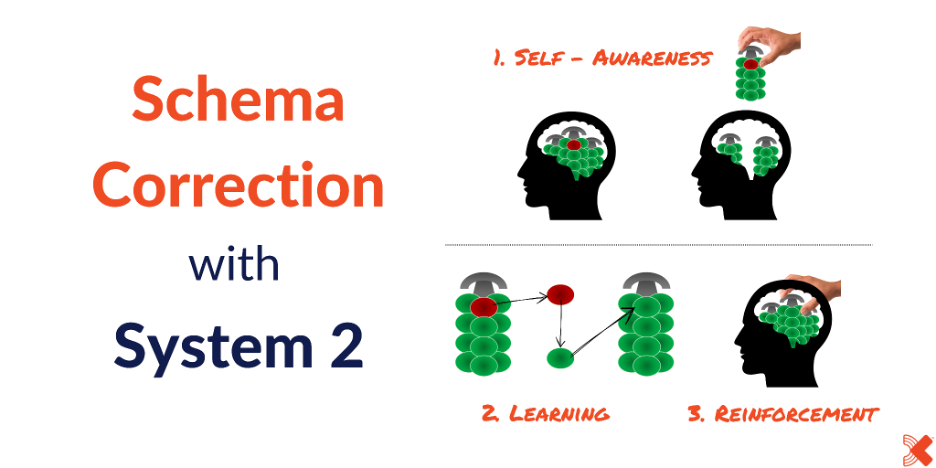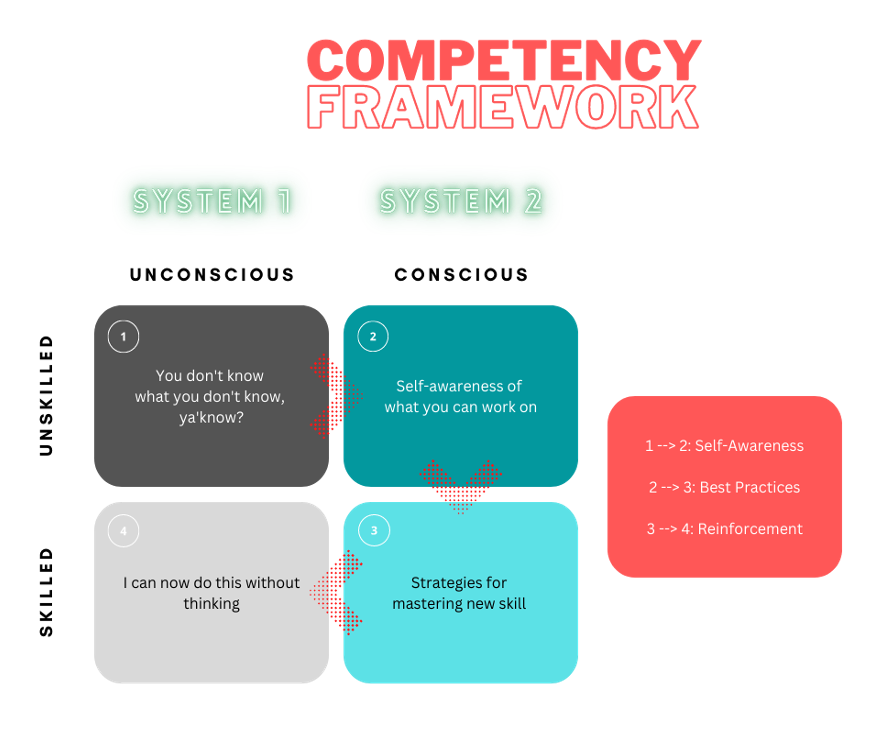Managing Biases & Heuristics for People First Leadership

Ever heard the exercise called the Kahneman General Store problem?
Let’s take an example. A bat and ball together cost $1.10. The bat costs one dollar more than the ball. How much does the ball cost?
Your instinctual answer was likely that the ball costs 10 cents. Either that or you were more logic-driven and checked your answer before deciding, figuring out that the ball actually costs 5 cents.
These two avenues of thought reflect the two types of thinking our brains engage in. The quick instinctual answer, or the slower, methodical, logic-driven approach.
The Two Systems to Tango
Daniel Kahneman, the author of this framework, describes the fast instinctual part of our brain as System 1.
System 1 accounts for unconscious thinking. It processes things fast and with minimal effort based on unconscious frameworks our brain has passively built over our lives.
System 1 is the unsung hero of our brains. It handles nearly all our cognitive load without any conscious processing. Think how tired you’d be if you’re processing everything consciously! Take walking down a crowded street. You’ve got to be aware of obstacles like cars, people, and streetlights, pace your steps, react to traffic signals and navigate your route. There are also passive bodily functions like blinking, breathing and balancing. Exhausting!
When we do something routine, our brain preserves as much energy as possible by conforming to routines and habits.
System 2 is the type of thinking most people can relate to. It's your conscious thought processes. You engage in System 2 thinking every time you interact with the world and attempt to solve a complex problem or make conscious choices to do something.
Most people see System 2 as the hero of the story because it stops you engaging in any problematic, automatic processes. Still, System 2 is often stingy and short on resources. Because it’s so much effort to use your System 2 brain, it only accounts for a tiny percentage of your cognitive load.
Think of it as a spotlight that runs on a battery. It's great for focusing your attention on a problem at hand. But you can only use it until the battery runs out. Then you start relying on System 1’s processing again. So, you must be tactful in how, and when, you use it.
Your brain’s priority is to save you energy and will rely on System 1 whenever possible. But what makes System 1 so efficient? Over time your brain starts creating channels, or neural pathways, for standard operations in your brain.
Remember when you first learned to ride a bike? You had to process everything you were doing consciously.
- Push down on the pedal for forward momentum.
- Balance my weight left and right to not fall over.
- Stay aware of my surroundings to avoid obstacles and threats.
- Plan my intended route.
- There’s a turn coming up. Lean and slightly turn the wheel.
- Rebalance.
- If I fall, aim for something soft.
This explains why we all looked like baby gazelles trying to walk for the first time until our brains started to group these functions and run them together. Now when you ride a bike, you just have to tell your brain, “Go!”.
That’s the beauty of System 1. Neurons that fire together, wire together (The Hebbian Learning Rule). We get more efficient in our cognitive processing every time we do something, and those processes become more natural over time. However, this also means they become much harder to change.
Your System 1 is made up of Schemas and Heuristics.
A Beginner’s Explanation to Schemas & Heuristics
Schemas are more associated with what topics a person might make decisions on, and heuristics are more associated with how those decisions are made. Schemas are a standard workflow or storyboard for deciding what to do in a recurring situation (like riding a bike). A heuristic is a framework of preferences helping you make decisions when you don’t have complete information, or don’t care enough, to make an informed decision.
For example, when deciding what type of yogurt to buy, you may gravitate towards a familiar brand, rather than cross-examine every yogurt brand for preferred flavors. You may consider nutritional information or quality of taste instead. These building blocks stop our brains exploding from the immense stimuli we're bombarded with daily.
Scientists have measured the amount of data that enters the brain, discovering that an average living person processes as much as 74 GB of information daily. That’s as much as watching 16 movies through TV, computers, cell phones, tablets, billboards, and many other gadgets!
Additionally, the processing capacity of the conscious mind has been estimated at 120 bits per second.
There is a flip side to these schemas and heuristics. Sometimes, unbeknownst to us, our processes start drawing inaccurate conclusions. When a heuristic consistently leads us to an inaccurate train of thought, we call that a bias. While these biases are formed to help you save time and cognitive effort, they also land you in some problematic situations. Especially socially or professionally.
For example, take the Confirmation Bias, one of our most powerful and consistent biases. The heuristic wants to save us time and effort, so rather than consider every possible outcome in a scenario and tediously rationalize which choice is the most logical, we form a hypothesis around what we think is most likely, and then look for information to confirm it.
Most of the time, this heuristic saves us time and effort. Other times, it keeps us from drawing the most accurate conclusions or dismissing information that may disagree with our hypothesis.
So how do we curb these problematic patterns in processing and keep our heuristics from creating bias blind spots? The answer is self-awareness.
This is one of the greatest evolutionary tools gifted to humanity. We’re one of the only species that possess metacognition, defined as the awareness and understanding of our own thoughts and patterns.
So, we can run this metacognitive thinking to see whether or not we’re falling victim to these bias traps, but it takes serious introspection, openness to our flaws, and complete honesty with ourselves to admit when we engage in these problematic thought processes.
Once we’re aware of these biases, we use our conscious and logical System 2 brain to rewire these patterns in thought and commit to putting accountability checks into our heuristics in the future to ensure we reach more accurate conclusions.
That, in a nutshell, is how to use our System 2 brain to rework the patterns in thinking created by System 1.
Now, here’s a framework for how you can rebuild schemas or heuristics in any scenario with anyone.
Everyone starts their learning journey in the top-left quadrant. ‘You don’t know what you don’t know until you know, ya’know?’
Being self-aware about an issue is the first step to addressing it. How can we support our self-aware thinking? There’s no one right answer. But being open to learning from your mistakes and keeping a growth mindset is a good baseline answer.
Five Ways to Support Your Self-Awareness:
1. Ask Yourself “Why”Why do you think that? Why is that my conclusion? Why do I trust this? Self-aware people are open to challenging themselves because they believe in the process of critical thinking. So, ask yourself “why”.
2. Trace Your AssumptionsWhenever you make a declarative statement (“That’s the way things are,” “This is the best course of action,” “This is what we should do”), trace your reasoning back as far as you can. Evaluate the objectivity of your statement.
3. Own Your Strengths and WeaknessesWhat comes easier to you than others? What have you struggled with more than others? Learn to leverage your strengths wherever you can but continue developing and be conscious of what you struggle with. It’s good to know what these are and be honest about where we are in our learning journey. It takes months to form habits and years to master something.
4. Self-ConceptHave a relationship with yourself like your relationships with others. Be curious about yourself and have personal hobbies. Looking for a New Year’s resolution? Make metacognition a regular exercise. Journal, meditate, exercise, or go to coaching or therapy. Know what you want and what you’re working on.
5. Trusted PeersNo one tells it to you quite as straight, or bluntly, as your friends. Dedicate time and effort into figuring out whose opinions you trust and keep those people close. Develop candid relationships where you know their criticism is constructive. You want someone who’ll call you out and challenge your perspectives. Without being unkind of course.
Self-awareness gets us to the point of realizing there’s a problem, but to address these problems and find a more ideal outcome, we need to learn best practices. Either from books, blogs, conferences, podcasts, or classes (like the ones we offer here at DX). Make sure you do your due diligence and ensure your sources are credible, or you may end up worse off.
Three Tips for Compensating for a Bias
1. Assume You Have ThemWe’re running 21st Century software on caveman hardware; we’re bound to make mistakes. The first step to progress is admitting you have a problem, and admitting you suffer from biases is just about the most human thing you can do.
2. Seek Out Faulty WiringWhen making decisions, putting a plan together, or evaluating a situation, look for the biases most likely to affect you. Doing research to prove a point? Check for confirmation bias. Evaluating your team’s performance? Check for attribution error, recency bias, halo bias, etc. If you understand the circumstances that lead to a bias, you can stop it before it starts.
3. Accountability ChecksSimilar to point two, if you know a bias is likely to surface in certain situations, remember to think critically. This is best used where you frequently witness biases, like brainstorming sessions or regular strategy meetings. Make checkpoints to ensure your reasoning is well-rounded.
Finally, all this work will be for nothing if you can’t layer it back into your subconscious. This is where many fall short. If the new concepts are not reinforced, then your unconscious processing will remain the same, and when you encounter the same situation in the future, you’re likely to return to your default processes.
This can explain why sometimes, we have clear and strong intentions to change a behavior but fall back into our default habits the moment we lose focus, like breaking a diet when we’re out with friends or biting our nails when stressed. Interrupting habits and routines can be difficult because they’re deeply ingrained in our unconscious. This is why you will often leave a professional seminar energized with ideas about the changes you can make and then immediately lose sight of them once every day life’s stresses take over again.
Just because System 2 is aware of something, doesn’t mean System 1 has overridden your mind. From what we know about System 1, it’s mostly instinct driven and automatic in its processing. So, the idea of engaging System 2 needs to become more automatic and instinctual. That way, when our brain is stressed and trying to run these processes automatically, they default to the rebuilt heuristic rather than the problematic one from before.

So how do we layer these new best practices into our subconscious? Reinforcement.
After all, neurons that fire together wire together. We need to continue to reinforce these concepts, so they become the new default pattern in thinking. You must understand that it won’t happen overnight. It takes effortful and consistent practice. Repeating the task or objective repeatedly. Like how we had to force ourselves to get back on the bike whenever we fell and keep reinforcing those skills until they become instinctual. You can do this by focusing your conscious effort on addressing this issue for a long enough period until it becomes habitual and instinctual.
That, in a sense, is how you can use your System 2 brain to rebuild some of the constructs that your System 1 brain has built over the years. If you find yourself slipping back into old behavior patterns, don’t get discouraged, it just means you need to continue practicing reinforcement. Depending on the person, task, and circumstances, it can take anywhere from 18 - 254 days to form a new habit, with most averaging about 66 days.
These concepts are universally applicable, but here at DX, we’re here to help people create more effective workplaces by making people aware of innate needs and preferences of human psychology. This thinking fast & slow framework can help you understand how your team thinks and makes decisions.
It can show you how stress mitigates your team’s ability to think logically. It shows you why bad work habits are so hard to shake. But by mastering this framework and applying it consistently over time, you can create lasting changes in your team (with less backsliding). It just takes self-awareness, effective resources, and consistent reinforcement.
Insights

Subscribe to Our Monthly Newsletter!
For managers and talent professionals who truly believe in putting people first, the CARE to Win blog is your gateway to the latest insights on human-centric leadership. Join us as we champion the people first movement.
Need some time apart? Are we emailing you too often? Just give us your feedback, and we promise we’ll respond. We really do care. And if it’s still too much, just unsubscribe. It’s cool.
 Ryan Aguiar
Ryan Aguiar






